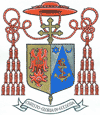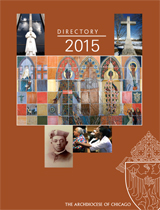
The Cardinal’s Column
Francis Cardinal George, O.M.I.
September 28, 2008
The centennial of the Diocese of Rockford: What does God remember?
Cardinal George's Schedule
- Sept. 28: 11:30 a.m., 175th Anniversary Mass, St. James Church at Sag Bridge, Lemont
- Sept. 28-29: Meeting of USCCB and Canadian Bishops (CCCB), Montreal, Canada
- Sept. 30: 5:30 p.m., St. Joseph College Seminary Rerum Novarum Award Reception
- Oct. 1: 3:30 p.m., Address seminary community, Mundelein Seminary; 4:45 p.m., Community Liturgy, Mundelein Seminary
- Oct. 2: 8 a.m., Big Shoulders Fund Lend a Shoulder Day; 5 p.m., Lumen Cordium Society Benefactors’ Reception, Residence
- Oct. 5-26: Council of the Synod of Bishops, Rome, Italy

Cardinal's Appointments
September 18, 2008
His Eminence, Francis Cardinal George announces the following appointments:
Pastor
Rev. Wojciech Baryski, S.Chr. to be the pastor of Five Holy Martyrs Church, South Richmond, effective immediately.
Rev. John Harvey to be the non-resident pastor of Queen of Apostles Parish, Riverdale, while retaining his duties as pastor of St. Mary of the Assumption Parish, East 137th Street, effective immediately.
Rev. Francisco Liporace, IVE, to be the pastor of St. Francis of Assisi Parish, West Roosevelt Road, effective immediately.
Administrator
Rev. Richard Shannon to be the administrator of St. Walter Parish, South Oakley, effective immediately until Nov. 30.
Rector
Rev. Marek Kasperczuk to be the rector of the Bishop Abramowicz Seminary Program, effective immediately.
Sabbatical
Rev. John Dearhammer, pastor of St. Gall Church, South Sawyer, to be on sabbatical from Sept. 1 to Feb. 1, 2009.
Rev. Steven Dombrowski, associate pastor of St. Edna Parish, Arlington Heights, to be on sabbatical from Oct. 10 to Feb. 9, 2009.
On Sept. 23, our neighboring Diocese of Rockford celebrated its 100th anniversary of foundation. 1908 was a significant year not only because that’s when the Rockford Diocese was established but also because that was the year when the entire United States ceased to be mission territory and began to be governed by the ordinary law of the church. Ceasing to be a mission territory didn’t mean the mission of the church was accomplished here; it only meant that the Holy See recognized that the church in this country was well established and could now begin to give and not just receive.
1908, for Cubs fans, was also the last year the north side team won the World Series; and expectation is high for making 2008 a repeat after a century of dashed hopes and frustration. Whether we remember the past of a baseball team, a family, a company or a country, what is remembered together creates a shared sense of identity, a community. Groups are distinguished not only by what they do now or desire for the future; they are also identified by what they remember. Ask a Canadian about the War of 1812, and you will discover a sense of history different that that found in the books we studied in school.
The history of the Catholic Church can be remembered and told through various prisms: Catholicism can be remembered and studied as a universal faith on the stage of human history for 2,000 years; the church’s part in the history of a particular country can be researched; the impact of the faith and its institutions on families or other groups can be written. The Catholic church is a network, a “communion” of local churches or dioceses, each governed by a bishop in apostolic succession. The mutual recognition by bishops that they share the same faith in union with the bishop of Rome is the visible sign of the universal church’s unity.
Because the church exists visibly in dioceses, church history is often studied pontificate by pontificate or, locally, bishop by bishop. When we look at the history of the Diocese of Rockford, we see that many of its bishops came from the Archdiocese of Chicago. The founding bishop, Peter Muldoon, and his successor, Edward Hoban, were both Auxiliary Bishops of Chicago before becoming Bishop of Rockford. The fourth Bishop, Raymond Hillinger, and his named successor, Donald Carroll, were also Chicagoans. The last two Bishops of Rockford are native sons: the Most Reverend Arthur O’Neill and the present Bishop, the Most Reverend Thomas Doran.
Chicago had a shared history with Rockford from 1843, the date when the Diocese of Chicago was founded, until 1908. When Chicago was made a diocese, its territory covered the entire State of Illinois. The first part of the state to become a separate diocese was Springfield in 1853, covering southern Illinois. Then the Diocese of Peoria was created in central Illinois in 1877. The Diocese of Belleville came into existence in 1887, and Rockford followed in 1908. The “youngest” diocese in Illinois is Joliet, founded in 1948. Since then, Chicago has had as its territory only Cook and Lake counties, although the Archdiocese of Chicago counts almost as many baptized Catholics as the other five dioceses of Illinois.
The church in Illinois has constantly received new Catholics from many nations, from the Irish and the Germans in the middle decades of the 19th century to the Poles and other Slavic peoples in the latter decades of the 19th century. The movement of African Americans from the south was not an immigration, but it was an encounter of cultures that impacted greatly the church’s mission here. The immigrants from the Philippines and Asia and Latin America and, most recently, from Africa change again the church’s sense of who she is. Over a third of the Catholic families of the archdiocese now are originally Spanish speaking.
People move from one homeland to another for many reasons; but the history of the church’s institutions, of its parishes and schools, its hospitals and social services, its organizations, religious orders, sodalities and movements is marked by the struggle to receive each generation of immigrants and reshape the church to fit new demands.
The Second Vatican Council said the church reads the “signs of the times.” This means that the church as an actor in human history is to be aware of the way God’s providence is guiding the human family and is to attend to new calls in every generation. Reading the signs of the times collectively is similar to the discernment of spirits individually. Every man or woman who desires to follow God’s will through life develops a sense of how God’s grace is guiding his or her actions and leading each of us to sainthood. A discerning person has a sense of what is to be done and what avoided on the path to greater unity with God. The church tries to discern her own path by looking inside the currents of history from God’s point of view.
Reading the signs of the times does not mean simply following social trends, for trends in society can have many sources, not all of them holy. Reading the signs of the times means recognizing God’s actions in history, watching for patterns that take us beyond recording only what human beings do or noting how natural changes shape human responses. Asserting that we cannot understand adequately our own history without some awareness of what God is doing sounds strange to many; but in the end, after all is said and done, history, both personal and social, is what God remembers.
Without knowing fully the mind of God, we celebrate 100 years of human participation in God’s designs in that part of Illinois that is the Diocese of Rockford. Like any anniversary, it’s an occasion to take stock, to look back in order to understand the present and plan the future. I hope that the Catholics of the Archdiocese of Chicago will take this centennial celebration as a moment to pray for the Catholics of the Diocese of Rockford. In prayer, we remember each other before God. In prayer, we strengthen the unity of who we are in Christ. In prayer, we sense how God is leading us through history. God bless you.
Sincerely yours in Christ,
Francis Cardinal George, OMI
Archbishop of Chicago
 Catholic
New World - Newspaper for the Archdiocese of Chicago
Catholic
New World - Newspaper for the Archdiocese of Chicago Archdiocese of Chicago Directory
Archdiocese of Chicago Directory Oficjalne wydawnictwo Archidiecezji Chicago w języku polskim
Oficjalne wydawnictwo Archidiecezji Chicago w języku polskim